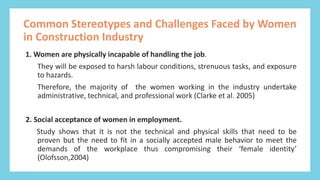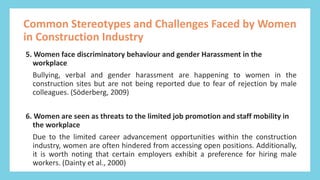Module 1 - Identifying Common Stereotypes.pptx
- 1. E m p o w e r i n g W o m e n i n C o n s t r u c t i o n Despite increasing efforts to promote diversity and inclusion in the construction industry, women still face a range of common stereotypes that can affect their experiences and opportunities. By challenging these stereotypes, the industry can attract and retain talented women professionals who can contribute to its growth and success. Vocational educators, policymakers, companies, and the workforce, including men and women, can all challenge these stereotypes. LetŌĆÖs explore the most common stereotypes are and what are their sourcesŌĆ” Common stereotypes and misconceptions about women in construction
- 2. E m p o w e r i n g W o m e n i n C o n s t r u c t i o n 1. Women are physically incapable of handling the job. They will be exposed to harsh labour conditions, strenuous tasks, and exposure to hazards. Therefore, the majority of the women working in the industry undertake administrative, technical, and professional work (Clarke et al. 2005) 2. Social acceptance of women in employment. Study shows that it is not the technical and physical skills that need to be proven but the need to fit in a socially accepted male behavior to meet the demands of the workplace thus compromising their ŌĆśfemale identityŌĆÖ (Olofsson,2004) Common Stereotypes and Challenges Faced by Women in Construction Industry
- 3. E m p o w e r i n g W o m e n i n C o n s t r u c t i o n 3. Women have a greater risk to have work-related musculoskeletal disorder (MSD) This happens when women work over the safe limit of their bodies to avoid being stereotyped by male colleagues. The injury is often the reason that leads women to leave the construction industry (Wangle, 2009). 4. The construction workplace was not built to accommodate female workers A study by OSHA (1990) revealed that most of the tools, equipment, and clothing are not designed for a womenŌĆÖs physique. Another example would be unclean facilities and temporary sanitary facilities without privacy. Common Stereotypes and Challenges Faced by Women in Construction Industry
- 4. E m p o w e r i n g W o m e n i n C o n s t r u c t i o n 5. Women face discriminatory behaviour and gender Harassment in the workplace Bullying, verbal and gender harassment are happening to women in the construction sites but are not being reported due to fear of rejection by male colleagues. (S├Čderberg, 2009) 6. Women are seen as threats to the limited job promotion and staff mobility in the workplace Due to the limited career advancement opportunities within the construction industry, women are often hindered from accessing open positions. Additionally, it is worth noting that certain employers exhibit a preference for hiring male workers. (Dainty et al., 2000) Common Stereotypes and Challenges Faced by Women in Construction Industry
- 5. E m p o w e r i n g W o m e n i n C o n s t r u c t i o n A womanŌĆÖs place is wherever she wants it to be, even in the cab in a 40-ton bulldozer ŌĆō National Centre for Construction Education and Research ŌĆō
Editor's Notes
- #3: References: Aulin, R., & Jingmond, M. (2011). Issues confronting women participation in the construction industry. In J. Mwakali, & H. Alinaitwe (Eds.), [Host publication title missing] (pp. 312-318). Makere University, Uganda. Olofsson, B., 2004. Kvinnor och m├żn i byggyrken ŌĆō en j├żmf├Črande studie. Byggkommissionen, Stockholm. (In Swedish).
- #4: References: Wangle, A.M. 2009. Perceptions of traits of women in construction. PhD thesis. University of Florida. OSHA, 1999. Women in the construction workplace: Providing equitable safety and health protection, US Department of Labour
- #5: References: Dainty, A.R.J., Bagilhole, B.M. and Neale R.H., 2000. A grounded theory of womenŌĆÖs career under-achievement in large UK construction companies. Construction Management and Economics, 18:2, 239-250. S├Čderberg, A. 2009. Kvinnor k├żnner sig utanf├Čr. Byggv├żrlden, 8th January




